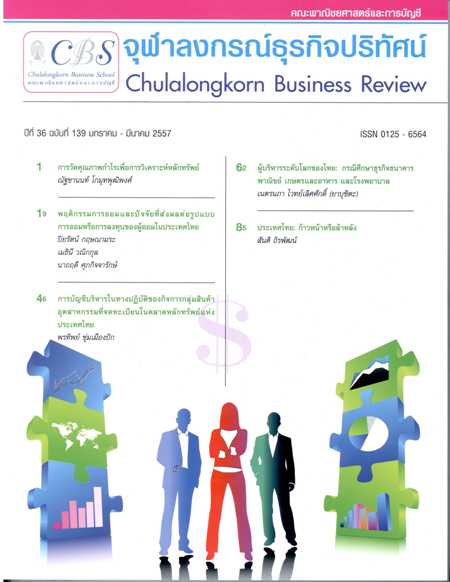พฤติกรรมการออมและปัจจัยที่ส่งผลต่อรูปแบบการออมหรือการลงทุนของผู้ออม ในประเทศไทย
Keywords:
การออม, พฤติกรรมการออม, รูปแบบการออม, เหตุผลในการออม, Saving, Saving behavior, Saving Instruments, Determinants of Saving.Abstract
บทคัดย่อ
โครงการวิจัยเรื่อง พฤติกรรมการออมและปัจจัยที่ส่งผลต่อรูปแบบการออมหรือการลงทุนของผู้ออมในประเทศไทย ดำเนินการเก็บข้อมูลปฐมภูมิในมิติต่างๆโดยการใช้แบบสอบถามที่ออกแบบโดยคณะผู้วิจัย สอบถามกลุ่มประชากรในเขตกรุงเทพมหานครและปริมณฑล เชียงใหม่ นครราชสีมา ระยอง และสงขลา ที่มีรายได้ตั้งแต่ 20,000 บาทขึ้นไป และมีอายุตั้งแต่ 20 ปี เป็นจำนวนทั้งสิ้น 844 ตัวอย่าง เพื่อนำมาวิเคราะห์ถึงระดับการออมและวัตถุประสงค์ในการออม รูปแบบการออม และปัจจัยหลักที่ส่งผลต่อการตัดสินใจเลือกรูปแบบการออม รวมทั้งศึกษาถึงความสอดคล้องระหว่างความรู้ความเข้าใจของผู้ออมในเรื่องความเสี่ยงและผลตอบแทนกับรูปแบบที่เลือกออม โดยให้ความสำคัญกับรูปแบบการออมผ่านตลาดทุน ผลที่ได้จากการศึกษาจะทำให้เข้าใจถึงลักษณะ แนวคิด และปรัชญาในการออมและการลงทุน รวมทั้งปัญหาและอุปสรรคในการออมของผู้ที่มีเงินออมในประเทศไทย ซึ่งจะสามารถนำไปในใช้พิจารณากำหนดและปรับปรุงนโยบายตลอดจนมาตรการต่างๆในอันที่จะเพิ่มปริมาณการออมและการลงทุนในประเทศโดยเฉพาะอย่างยิ่งการออมผ่านตลาดทุนไทย
จากผลการวิจัยพบว่ากลุ่มตัวอย่างของผู้ออมในประเทศไทยโดยเฉลี่ยมีการศึกษาในระดับปริญญาตรีและมีความรู้ความเข้าในเรื่องความเสี่ยงและผลตอบแทนดี มีอายุโดยเฉลี่ย 47 ปีและมีรายได้ปานกลางจากการทำงานประจำ อัตราการออมเฉลี่ยร้อยละ 29.17และสนใจการออมทุกรูปแบบ วัตถุประสงค์หลักในการออมคือเพื่อไว้ใช้หลังเกษียณ ผู้ออมจะเป็นผู้ตัดสินใจเลือกวิธีการลงทุนด้วยตัวเองโดยอาศัยข้อมูลจากบุคคลในครอบครัวและเจ้าหน้าที่ของธนาคาร ผลการวิจัยพบว่าผู้ออมเลือกลงทุนในรูปแบบการออมแบบดั้งเดิมที่ผู้ออมรู้จักดี ได้แก่ การฝากเงินธนาคาร การทำประกันชีวิต การซื้อทองรูปพรรณและ/หรือทองคำแท่ง และการซื้ออสังหาริมทรัพย์ มากกว่าการลงทุนซื้อตราสารการเงินผ่านตลาดทุน ซึ่งได้แก่พันธบัตรรัฐบาล กองทุนรวม หุ้นกู้และหุ้นสามัญ อย่างไรก็ดี เมื่อผู้ออมมีรายได้เพิ่มขึ้นพบว่ามีแนวโน้มที่จะออมในรูปแบบดั้งเดิมลดลงและลงทุนซื้อตราสารการเงินในตลาดทุนมากขึ้น นอกจากนี้ผลการวิจัยยังพบว่าผู้ออมมีความเข้าใจดีว่าการลงทุนซื้อตราสารการเงินได้รับผลตอบแทนสูงแต่ก็มีความเสี่ยงสูง ต้องใช้เงินลงทุนมากและมีความซับซ้อนเข้าใจยากจึงสนใจลงทุนน้อย ในการจัดสรรเงินออม ผู้ออมให้ความสำคัญต่อการจัดสรรเงินเพื่อลงทุนซื้ออสังหาริมทรัพย์มากเป็นอันดับหนึ่ง เนื่องจากความต้องการมีที่อยู่อาศัยเพื่อความมั่นคงของครอบครัว และมีความเชื่อว่าการลงทุนประเภทนี้มีผลตอบแทนสูงและมีความเสี่ยงน้อยกว่าการลงทุนในตราสารการเงิน
คำสำคัญ: การออม พฤติกรรมการออม รูปแบบการออม เหตุผลในการออม
Abstract
The study of household savings behavior and determinants of the forms of savings and investment in Thailand is based on the primary data of 844 people through questionnaires in Bangkok and its perimeter, Chiangmai, Nakhonratchasima, Rayong, and Songkhla. This study investigates level and objectives of savings of Thai household, forms of savings, determinants of the forms of savings, including consistency between the risk-return concept and the investing decision. The purpose of this study is to identify characteristics, concepts and philosophy of savings and invest of Thai household, including savings problems and obstacles. The results are expected to be beneficial in determining policies and measures to encourage savings and investment in Thailand, especially in the domestic capital market.
It is found that household savers in Thailand, on average, hold a bachelor degree and understand the risk-return tradeoff for investments. The average age is 47. Across the sample, they have medium level of income of which about 29.17% is saved. It is also found that savers are interested in every form of savings and investments mentioned in the questionnaire and their main purpose of savings is for post-retirement spending.
Our samples select forms of savings and investments on their own with information provided by bank officers and family members. Moreover, they tend to invest more in conventional forms of savings such as bank deposits, insurance policies, gold and properties then in financial assets such as government bond, mutual fund, corporate bonds, and stock. It is also interesting to find that as level of income increases, savers tend to save less in conventional forms and more their savings towards capital market. Despite the higher return, they might receive from investing in financial assets, savers have not much interest in these forms of investments owing to the high risk character, complicated investment process and large amount of minimum investment requirement. Properties (real estate) is the form of investment to which household savers allocate the largest proportion of their saving. The reason is simply because it is one of human basic needs. In addition, it is perceived that physical assets (real estates) generate higher return and are less risky than financial assets.
Keyword: Saving, Saving behavior, Saving Instruments, Determinants of Saving.
Published
How to Cite
Issue
Section
License
Opinions and discussions in papers published by the Creative Business and Sustainability Journal (CBSJ) are deemed as personal opinions and the responsibility of the writers. They are not the opinions or responsibility of the Chulalongkorn Business School of Chulalongkorn University.
Papers, content, information etc. appearing in the Journal are deemed to be the copyright property of the Chulalongkorn Business School of Chulalongkorn University. Anybody or any organization that wishes to publish any part of them or use them in any way must obtain written permission from the Chulalongkorn Business School, Chulalongkorn University.



